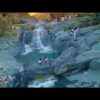Matterhorn Drone Film Shot Cervinia
Matterhorn Drone Film Shot Cervinia
Matterhorn Drone Film Shot Cervinia. The Matterhorn (Cervino) on the Italian side. The perfect blend between nature and man. a 5K UHD cinematic video featuring Cervinia, the Matterhorn, wild animals (Steinbock or Ibex) and the beautiful slopes of the Italian ski resort. The Cervino Ski Paradise in the Valle d'Aosta is the Matterhorn’s great ski district with 100 of km of ski slopes.
Cosmopolitan Breuil-Cervinia (2,050 mt) is the undisputed ski capital. In fact the winter season lasts a long six months (the longest season in Aosta Valley) and in summer it is possible to ski on the Plateau Rosà glacier (3,500 mt). Modern fast lift systems means ski connections also with Valtournenche and Zermatt (Switzerland) and these resorts make up the “Cervino Ski Paradise”, a snow paradise. The resort’s ski story started 80 years ago with the first cableway Cervinia-Plan Maison (Opened in 1936). The area was an already famous mountaineering hub from 1865 with the first ascent of the Matterhorn. The Matterhorn is a mountain of the Alps, straddling the main watershed and border between Switzerland and Italy. It is a large, near-symmetrical pyramidal peak in the extended Monte Rosa area of the Pennine Alps, whose summit is 4,478 metres (14,692 ft) high, making it one of the highest summits in the Alps and Europe. The four steep faces, rising above the surrounding glaciers, face the four compass points and are split by the Hörnli, Furggen, Leone/Lion, and Zmutt ridges. The mountain overlooks the Swiss town of Zermatt, in the canton of Valais, to the north-east and the Italian town of Breuil-Cervinia in the Aosta Valley to the south. Just east of the Matterhorn is Theodul Pass, the main passage between the two valleys on its north and south sides, and a trade route since the Roman Era. The Matterhorn is mainly composed of gneisses (originally fragments of the African Plate before the Alpine orogeny) from the Dent Blanche nappe, lying over ophiolites and sedimentary rocks of the Penninic nappes. The mountain's current shape is the result of cirque erosion due to multiple glaciers diverging from the peak, such as the Matterhorn Glacier at the base of the north face. Sometimes referred to as the Mountain of Mountains (German: Berg der Berge), the Matterhorn has become an iconic emblem of the Swiss Alps and of the Alps in general. Since the end of the 19th century, when railways were built in the area, the mountain has attracted increasing numbers of visitors and climbers. Each year, numerous mountaineers try to climb the Matterhorn from the Hörnli Hut via the northeast Hörnli ridge, the most popular route to the summit. Many trekkers also undertake the 10-day-long circuit around the mountain. The Matterhorn has been part of the Swiss Federal Inventory of Natural Monuments since 1983.


